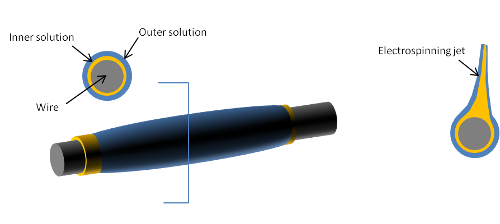Fibers with a core-sheath structure provide several advantages over homogeneous polymer fibers. Such a system has been investigated for use in producing hollow fibers, drug delivery fibers and spinning of low molecular weight polymer. The setup until now has been restricted to production at a lab-scale level. In conventional electrospinning with the use of orifice, microfluidic manifold may be used to construct multiple channels within a block of polydimethylsiloxane (PDMS) with a dual inlet for production of core-shell structure and multiple outlets for mass production electrospinning. Fluid inlet and outlet holes may be created by punching the several millimetres thick PDMS replicas using stainless steel luer stubs. To facilitate transfer of high voltage to the solution, stainless steel tubes are fitted into the outlets. Srivastava et al (2008) successfully tested this setup with the electrospinning of hollow poly(vinylpyrrolidone) (PVP) + titania (TiO2) composite and core/sheath polypyrrole (PPy)/PVP nanofibers of the order of 100 and 250 nm, respectively.
Using a needleless system, Yan et al has developed a setup that can potentially spin core-sheath fibers at a much greater production rate [Yan et al 2012]. A shown in the schematic, there are two triangular troughs with an outer and inner slit. During jet initiation, the drawing of the solution from the outer trough will exert a shearing force on the inner solution thereby drawing the inner solution concurrently. In their experiment, it was shown that a sheath solution with a higher viscosity than the core solution is better in maintaining a distinct core-sheath fiber. The core-sheath flow behaviour could be explained from the internal fluid pressure drop at core of the solution jet. This causes the inner core solution to preferentially drawn to the core of the jet [Yan et al 2015]. Another parameter that determines the formation of core-sheath fiber is differential flow velocity between the sheath and the core solution. A higher sheath solution flow velocity over the core solution is needed to create sufficient fluid shear force of the sheath solution acting on the core solution. Therefore, it is important that the flow rate of the sheath solution is sufficiently large to maintain a higher solution flow velocity at the sheath [Yan et al 2015]. An advantage of this setup is that the formation of core-sheath fiber is independent of the miscibility between both solutions. This is due to the short contact time between the solutions to allow mixing [Yan et al 2015].
In 2007, Bazilevsky et al showed that core-shell fibers can be electrospun using a single nozzle by mixing two solutions that forms separate layers. In their experiment, the lighter polyacrylonitrile/dimetylformamide solution floats on top of the heavier poly(methyl methacrylate)/DMF solution. Core-shell electrospinning was initiated whenever a droplet of the heavier poly(methyl methacrylate) solution was sucked into the jet. Although the droplet may seems small, the volume is sufficient to draw over a meter of core-shell fibers. As an evolution of this process, by passing a wire through two immiscible solutions, the wire is coated with two layers of solution [Forward et al 2012]. At sufficient voltage applied to the solution, electrospinning is initiated and a core-sheath fiber structure can be fabricated.
Published date: 17 Feb 2013
Last updated: 27 Oct 2015
▼ Reference
-
Bazilevsky A, Yarin A L, Megaridis C M. Co-electrospinning of Core-Shell Fibers Using a Single-nozzle Technique. Langmuir 2007; 23: 2311.
- Forward K M, Flores A, Rutledge G C. Coaxial-Free Surface Electrospinning. The Fiber Society 2012 Fall Meeting. Pp. 98
Open Access
-
Srivastava Y, Rhodes C, Marquez M, Thorsen T. Electrospinning hollow and core/sheath nanofibers using hydrodynamic fluid focusing. Microfluid Nanofluid 2008; 5: 455.
-
Yan X, Marini J, Mulligan R, Deleault A, Sharma U, Brennar M P, Rutledge G C, Freyman T, Pham Q P. Slit-Surface Electrospinning: A Novel Process Developed for High-Throughput Fabrication of Core-Sheath Fibers. PLoS ONE 2015; 10(5): e0125407.
Open Access
-
Yan X, Pham Q, Marini J, Mulligan R, Sharma U, Brenner M, Rutledge G, Freyman T. High-throughput needleless electrospinning of Core-Sheath Fibers. The Fiber Society 2012 Fall Meeting. Pp. 96
Open Access
▲ Close list
 ElectrospinTech
ElectrospinTech


